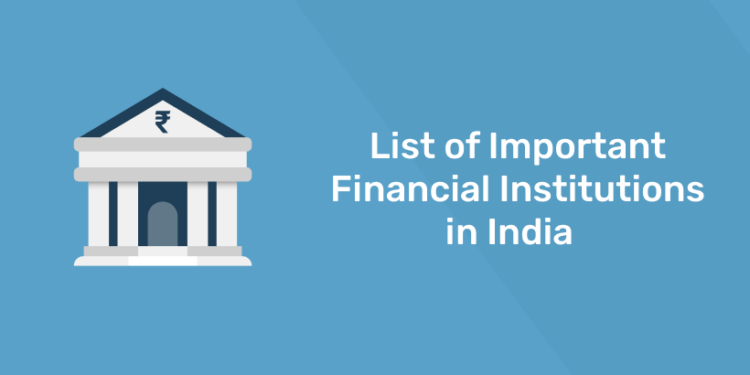Table of Contents
The Reserve Bank of India is the designated Central Banking Authority responsible for well-managed banking sector supervision in India. Monetary policy for banks is overseen by the RBI in India. Banks are categorized into four basic groups: cooperative banks, small financing banks, payment banks, and commercial banks. In addition to commercial banks, there are also private sector banks and public sector banks.Currently operating in India are ninety-one commercial banks. The Indian public sector bank sector comprises 20 banks, including SBI, and 19 nationalized banks. For all-inclusive information on bank classification
Prepare for Financial Bank Exams with Entri App!
Financial Institution in India: Overview
India’s financial system is diverse and multifaceted, encompassing a variety of institutions that perform distinct yet interconnected functions. The primary categories of financial institutions in India include:
Central Bank:
- The Reserve Bank of India (RBI) is the apex monetary authority responsible for regulating the financial system, managing the country’s currency, and ensuring economic stability
Commercial Banks:
- Public sector banks, private sector banks, and foreign banks operating in India provide a range of banking services to individuals, businesses, and government entities. State Bank of India (SBI) is the largest among these.
Cooperative Banks:
- These banks cater to the needs of rural areas and small businesses, promoting financial inclusion at the grassroots level.
Development Banks:
- Institutions like the National Bank for Agriculture and Rural Development (NABARD) and the Small Industries Development Bank of India (SIDBI) focus on sector-specific development, providing long-term finance and support.
Insurance Companies:
- The Insurance Regulatory and Development Authority of India (IRDAI) oversees the insurance sector, ensuring that policyholders’ interests are protected and promoting the growth of the industry.
Non-Banking Financial Companies (NBFCs):
- These institutions offer a variety of financial services, including loans and asset management, complementing the services provided by banks.
Securities Market Regulators:
- The Securities and Exchange Board of India (SEBI) regulates the securities market, protecting investors and ensuring market integrity.
Specialized Financial Institutions:
- Entities like the Export-Import Bank of India (EXIM Bank) and the Housing and Urban Development Corporation (HUDCO) provide targeted financial support to specific sectors such as international trade and urban development.
Financial Institution in India: Importance
Financial institutions in India are the backbone of the country’s economic framework. They play a pivotal role in driving growth, stability, and development across various sectors. From regulating monetary policies to providing financial services, these institutions ensure the smooth functioning of the economy. Here’s a detailed look at the importance of financial institutions in India
Economic Stability
- Financial institutions like the Reserve Bank of India (RBI) are crucial in maintaining economic stability.
- The RBI manages monetary policy, controls inflation, and ensures the stability of the currency.
- By regulating interest rates and managing liquidity, it helps to prevent economic crises and promotes sustainable growth.
Credit Provision
- Banks and financial institutions provide credit to individuals, businesses, and government entities
- Institutions like State Bank of India (SBI) and National Bank for Agriculture and Rural Development (NABARD) offer loans for various purposes including personal needs, business expansion, and agricultural development.
- This credit provision fuels economic activities and supports entrepreneurship.
Development of Infrastructure
- Financial institutions like the Housing and Urban Development Corporation (HUDCO) play a key role in funding infrastructure projects.
- They provide long-term finance for the development of housing and urban infrastructure, which is essential for economic growth and improving living standards.
Regulation and Supervision
- Regulatory bodies such as the Securities and Exchange Board of India (SEBI) and the Insurance Regulatory and Development Authority of India (IRDAI) ensure that financial markets operate fairly and transparently.
- They protect investors and policyholders, promote market integrity, and prevent fraudulent activities.
Promoting Investment
- Institutions like the Industrial Development Bank of India (IDBI) and the Export-Import Bank of India (EXIM Bank) encourage investment in various sectors.
- By providing financial assistance and guarantees, they support industrial development and promote exports, contributing to economic diversification and growth.
Financial Inclusion
- Financial inclusion is a key goal for many institutions, ensuring that financial services are accessible to all sections of society.
- The Small Industries Development Bank of India (SIDBI) focuses on providing financial support to micro, small, and medium enterprises (MSMEs).
- This helps in reducing poverty and promoting inclusive growth by empowering small businesses and entrepreneurs.
Agricultural and Rural Development
- NABARD is dedicated to promoting sustainable agriculture and rural development.
- It provides financial assistance for agricultural projects and rural infrastructure, supports small and medium-sized enterprises in rural areas, and promotes self-help groups and microfinance institutions.
- This leads to rural prosperity and reduces urban-rural disparities.
Supporting Pension and Insurance Sectors
- Institutions like the Pension Fund Regulatory and Development Authority (PFRDA) and IRDAI play a vital role in securing the future of individuals by regulating pension funds and the insurance industry.
- They ensure that these sectors are financially sound and operate in the best interests of the subscribers and policyholders.
Facilitating International Trade
- EXIM Bank supports the country’s international trade by providing financial assistance to exporters and importers. It helps in bridging the trade finance gap, providing lines of credit to overseas buyers, and facilitating export-oriented projects.
- This enhances India’s global trade presence and economic strength.
Innovation and Technology Adoption
- Financial institutions are also at the forefront of adopting new technologies and promoting innovation.
- They invest in digital banking, fintech solutions, and other technological advancements to enhance service delivery, improve efficiency, and provide better customer experiences.
- This drives modernization and competitiveness in the financial sector.
Financial Institution in India: List
India has a diverse and complex financial system, supported by numerous institutions. These institutions play a crucial role in the development of the economy by managing monetary policy, regulating markets, and providing financial services to individuals and businesses. Here’s an overview of some of the most important financial institutions in India:
Reserve Bank of India (RBI)
The Reserve Bank of India is the central bank of India. It regulates the monetary policy of the Indian rupee. It was established on April 1, 1935, under the Reserve Bank of India Act, 1934.
Key Functions:
- Regulating the issue of banknotes.
- Maintaining reserves to secure monetary stability.
- Operating the currency and credit system of the country.
- Managing foreign exchange.
- Acting as a banker to the government.
State Bank of India (SBI)
State Bank of India is the largest public sector bank in India. It provides a range of banking and financial services to individuals and businesses.
Key Functions:
- Offering savings and current accounts.
- Providing loans for personal, commercial, and industrial purposes.
- Facilitating international banking and trade finance.
- Offering investment services.
National Bank for Agriculture and Rural Development (NABARD)
NABARD focuses on the development of agriculture and rural areas. It was established in 1982 to promote sustainable and equitable agriculture and rural prosperity.
Key Functions:
- Providing financial assistance for agricultural development.
- Supporting rural infrastructure projects.
- Offering credit to small and medium-sized enterprises in rural areas.
- Promoting self-help groups and microfinance institutions.
Industrial Development Bank of India (IDBI)
IDBI was established in 1964 to provide credit and other financial facilities for the development of industry in India. It has since evolved into a full-service universal bank.
Key Functions:
- Providing project finance and infrastructure funding.
- Offering investment banking services.
- Supporting small and medium enterprises (SMEs).
- Facilitating retail banking services.
Export-Import Bank of India (EXIM Bank)
EXIM Bank was established in 1982 to promote Indian exports. It provides financial assistance to exporters and importers.
Key Functions:
- Offering export credit and guarantees.
- Providing lines of credit to overseas financial institutions.
- Supporting export-oriented units.
- Facilitating international trade and investment.
Small Industries Development Bank of India (SIDBI)
SIDBI was established in 1990 to promote, finance, and develop micro, small, and medium enterprises (MSMEs) in India.
Key Functions:
- Providing direct and indirect financial assistance to MSMEs.
- Offering refinancing services to banks and financial institutions.
- Supporting credit and equity support to small businesses.
- Promoting innovation and entrepreneurship in the MSME sector.
Securities and Exchange Board of India (SEBI)
SEBI is the regulatory body for the securities market in India. It was established in 1988 and given statutory powers in 1992.
Key Functions:
- Regulating stock exchanges and securities markets.
- Protecting the interests of investors.
- Promoting and regulating self-regulatory organizations.
- Prohibiting fraudulent and unfair trade practices.
Insurance Regulatory and Development Authority of India (IRDAI)
IRDAI is the regulatory body for the insurance sector in India. It was established in 1999.
Key Functions:
- Regulating and promoting the insurance and reinsurance industry.
- Protecting policyholders’ interests.
- Ensuring the financial soundness of the insurance industry.
- Promoting fair competition and orderly growth of the insurance market.
Pension Fund Regulatory and Development Authority (PFRDA)
PFRDA is the regulatory body for pension funds in India. It was established in 2003 to promote old age income security.
Key Functions:
- Regulating the National Pension System (NPS).
- Protecting the interests of NPS subscribers.
- Promoting pension sector growth.
- Ensuring orderly development of pension funds.
Housing and Urban Development Corporation (HUDCO)
HUDCO was established in 1970 to finance housing and urban infrastructure projects in India.
Key Functions:
- Providing long-term finance for housing and urban development.
- Supporting low-cost housing projects.
- Financing infrastructure development in urban areas.
- Promoting sustainable urban development practices.
These institutions are the backbone of India’s financial system. They ensure the stability and growth of the economy by providing essential financial services, regulating markets, and promoting development across various sectors.
Take Entri’s Free Mock Test for Banking Examinations!
Financial Institution in India: Conclusion
Financial institutions are the lifeblood of India’s economy. They provide critical services that facilitate economic growth, stability, and development. By managing monetary policy, offering credit, supporting infrastructure projects, and promoting financial inclusion, these institutions play a vital role in the country’s progress. A financial institution is an establishment that engages in financial activities such as lending, depositing money, and making investments. It is essential to the economy because it transfers funds from savers to borrowers, makes resource allocation possible, and fosters economic progress.










